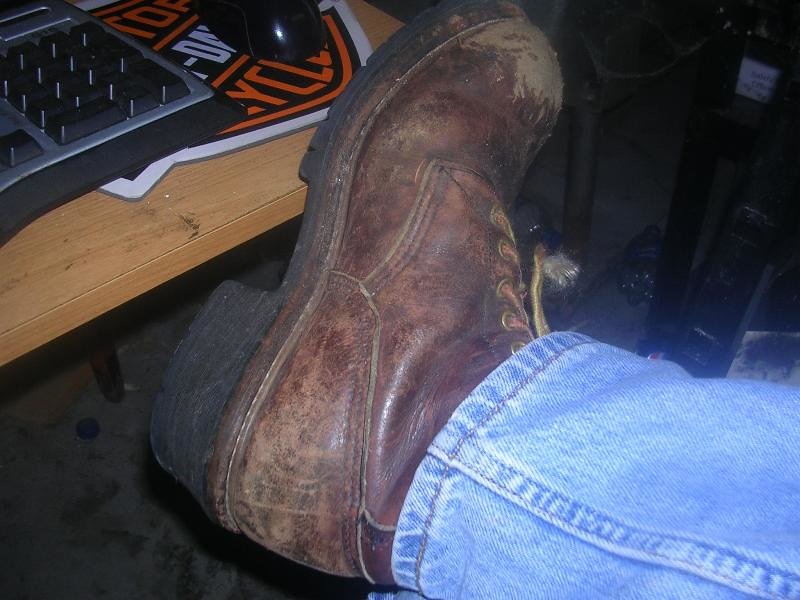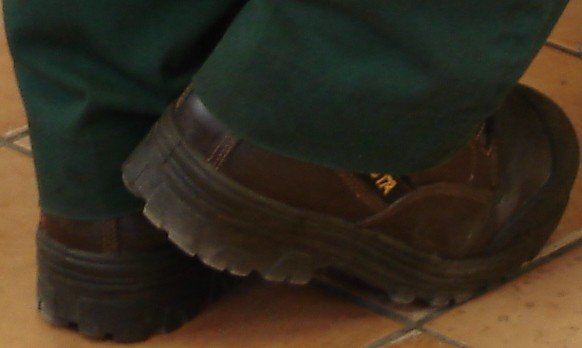The dreaded heel rub. It’s one of those common problems that can stop your day in its tracks. If you’ve ever experienced the pain of work boots rubbing against the back of your heel, then you know just how uncomfortable and irritating it can be. The good news is, there are some simple solutions to this age-old problem, so you can get back to your day with your feet feeling as good as new.
With the proper care, your work boots can be adjusted to fit comfortably and prevent any further irritation. The primary cause of heel rubbing is a lack of support, and this can be remedied by adding an insole to your boots. Insoles provide extra cushioning, arch support, and heel stability, which can help prevent the back of your heel from rubbing.
According to a study by the American Academy of Podiatric Sports Medicine, the most common cause of foot pain in workers wearing work boots is heel rubbing from the back of the boot.
Why do my shoes rub the back of my ankle?
The most common reason why shoes rub the back of the ankle is that they are the wrong size. Shoes that are too big or too small can cause the heel to rise up and down as you walk, resulting in friction and rubbing at the back of the ankle. Similarly, shoes that are too tight can press against the ankle, causing discomfort.
Dr. Jeffrey P. Oster of the American College of Foot and Ankle Surgeons says, “Shoes that are too tight or too loose can cause friction and rubbing of the back of the ankle, leading to discomfort and potential skin problems.”
Another cause of shoe rubbing at the back of the ankle can be improper fit. Shoes that are too narrow, too wide, too wide at the toe, or too long can cause the heel to rise and down as you walk and can rub at the back of the ankle.

Dr. Amit Garg, Board-Certified Podiatrist, and Foot and Ankle Surgeon, says, “Shoes that don’t fit properly can cause the heel to rise and down as you walk, leading to friction and discomfort at the back of the ankle.”
In addition, shoes that are worn out or of poor quality can also cause the heel to rise and down as you walk and cause friction at the back of the ankle. Worn-out shoes can also cause the heel to move around too much, resulting in rubbing and discomfort.
Wearing shoes without socks can cause friction and rub on the back of the ankle as the shoe moves against the skin. This is especially true if the shoes are made of a material that is not breathable.
Dr. Young recommends “wearing socks with your shoes to reduce friction and provide a layer of cushioning between the shoe and skin.”
When you walk, too stiff or cushioned shoes can also make the heel rise and drop as you walk, rubbing against your ankle.
Prevent work boots rubbing back of heel – 8 Effective Methods
1. Wear Boot Socks
Boot socks minimize the chances of your work boots rubbing your heel. Boot socks provide an extra layer of cushion between your heel and the back of the boot, helping to keep your heel comfortable and blister-free. Make sure to choose socks made of breathable materials to further reduce the chance of rubbing and discomfort.
2. Wear Heel Grips
Heel grips are designed to help reduce the amount of friction between your heel and the back of your boot. Most heel grips are made of soft, cushiony material and are designed to fit on the back of your heel. They provide a barrier between your heel and the boot, preventing the boot from rubbing and causing blisters.
3. Wear Insoles
Insoles offer cushioning and support to the feet and can help reduce the rubbing of work boots. Choose insoles that are designed for work boots, as these will provide extra cushioning and support where you need it the most.
4. Break in the Boots
Wearing your work boots lessens the likelihood of rubbing on your heel. Wear the boots around the house for a few hours each day until they are comfortably broken in. This will Your heels will feel more comfortable and you will have less friction between them and the back of your boot.
5. Wear Two Pairs of Socks
Wearing two pairs of socks can also prevent rubbing. The first pair should be a thin sock, made of a breathable material, such as cotton or wool. The second pair should be a thick, cushiony sock that will provide extra padding between your heel and the back of the boot.
6. Apply Petrolatum Jelly
Applying a thin layer of petrolatum jelly to the back of your heel is a good way to reduce irritation. The jelly creates a slippery surface that helps reduce the friction between your heel and the boot. Be sure to wipe off any excess jelly to prevent it from getting onto your clothing.
7. Apply Talcum Powder
Applying talcum powder to the back of your heel will also relieve irritation. The powder creates a layer of lubrication that helps reduce friction between your heel and the boot. Make sure to apply the powder directly to your heel for the best results.
8. Use Moleskin
Moleskin is a type of fabric that is designed to reduce friction and protect the skin from rubbing and blisters. Cut a piece of moleskin to fit the back of your heel, and then apply it directly to your skin. This will help prevent the boot from rubbing against your heel, and it will also help keep your heel feeling comfortable.
Consequences Of Shoes Rubbing Your Ankle
Shoes that rub against the ankle can cause a variety of annoying and even painful consequences. Shoes that are too tight, too loose, or that have seams that don’t fit properly can cause the skin on the ankle to become irritated and inflamed. This can lead to a mild form of dermatitis, known as shoe dermatitis. It may present as a red, itchy rash, which may also be accompanied by overlying blisters.
In addition to shoe dermatitis, shoes that rub against the ankle can also cause blisters, calluses, and corns. Blisters are fluid-filled sacs that form on the skin as a result of friction between the shoe and the skin. Calluses and corns are hardened, raised areas of the skin caused by repeated friction and pressure. They often appear over bony protrusions such as on the toes and the ankle.
If these conditions are left untreated, they can become infected. Infections can be caused by bacteria, fungi, and/or viruses, and can lead to more serious consequences. For example, if a blister becomes infected, it could lead to cellulitis, a spreading infection of the skin and soft tissues that can be quite serious and require medical attention.
To avoid these consequences, it is important to make sure shoes fit properly. Shoes should be snug-fitting but not too tight, and should not cause any chafing or rubbing of the ankle.
It is also important to inspect the seams of the shoes to make sure they don’t overlap or protrude and cause friction. If the shoes are still rubbing against the ankle, it may be helpful to use a bandage or moleskin to provide cushioning.
Fix your shoes that hurt your feet

If your shoes are causing your feet to hurt, it can be a sign that something is not right. The first step in finding a solution is to identify the source of the problem. Depending on the type of shoe, there are a variety of causes for foot pain. Here are some tips on how to fix your shoes that hurt your feet.
1. Check the arch support
Lack of arch support can also cause foot pain. If your shoes do not have adequate arch support, consider adding an arch support insert or orthotic.
3. Replace worn-out soles
The soles of your shoes can wear down over time, leading to uneven surfaces that can cause discomfort. If your shoes have worn-out soles, it’s a good idea to replace them.
4. Ensure proper cushioning
Shoes that lack cushioning can also cause foot pain. Make sure your shoes have the right amount of cushioning for the activities you are doing.
5. Treat existing shoe-related foot pain
If you are already experiencing pain from your shoes, there are a few things you can do. Stretching exercises and massages can help to alleviate the pain. You can also purchase shoe inserts or orthotics to provide additional support.
FAQs
Over To You!
Based on the research and evidence gathered, it can be concluded that work boots rubbing the back of heel is a common problem for many people. The primary cause of this is ill-fitting boots that are too tight or too loose in the heel area.
However, it is possible to prevent and alleviate this condition by taking certain measures, such as selecting the right size and type of boots, wearing supportive insoles, and using protective heel guards. With the right prevention and treatment, it is possible to reduce the discomfort caused by work boots rubbing the back of heel.

I’m Richard Gravener, founder and editor of Bootzine. I have 19 plus years as Safety Officer in the construction industry. I have been qualified as a Safety Inspector since December of 2000, and have been a Workplace Safety Coordinator/Advisor since September of 2008.
Workplace safety First – Therefore, it’s crucial for workers to have good footwear to protect their feet from different dangers at work! On this blog, I aim to share all my knowledge and expertise in dealing with workplace safety, especially in choosing the right footwear for different jobs and foot care, hopefully, you can get something out of it. Enjoy!

